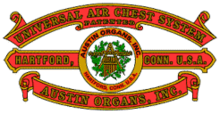 | |
| Industry | pipe organs |
|---|---|
| Founded | 1898 |
| Founder | John T. Austin |
| Headquarters | Hartford,CT , USA |
Key people | Michael B. Fazio (President), Richard G. Taylor (CEO) |
| Owner | private partnership |
| Website | austinorgans.com |
Austin Organs, Inc., is a manufacturer of pipe organs based in Hartford, Connecticut. The company is one of the oldest continuously-operating organ manufacturers in the United States.[1] The first instruments were built in 1893 with the Austin Patent Airchest, and many remain in fine playing condition to this day.
The Austin Organ Company was formally organized in 1898 by John Turnell Austin in Boston, Massachusetts, although it traces its beginning to 1893 with the first instruments Austin built at the Clough & Warren Company in Detroit, Michigan. In 1899 the company moved to Hartford.[2]
Austin was from England and had come to the United States in 1889. Austin's father Jonathan had a hobby of organ building. When son John made his way to Detroit he found work at the Farrand & Votey Organ Company. While servicing organs for Farrand, Austin worked with tracker and slider chests and some of the nascent electric mechanisms.[2] He developed what would be named the "Universal Air Chest System". This is an airtight chamber with the chest action on the ceiling of the chamber. A feature of this system was that the chest could be entered from below while the organ was turned on; this allowed for servicing of the organ keying action. The modern (current) chest design was further developed in 1913, and has been refined over the years. In 1905 the company began building electric consoles; these have also been refined over the years.

The Austin Organ Company reached its peak in the 1920s when it was delivering more than 80 instruments each year. In the Depression years the company struggled with high overhead, decreased new business, and cash flow. By 1935 the company announced that it would close after fulfilling existing contracts, with its last instrument as Opus 1885.[3] The company vacated its factory building, sold some assets and put others into storage.[2]
In February 1937 the nephew of the company founder and a long-term employee purchased what remained of the company and formed "Austin Organs, Inc." They re-established the factory in Hartford although in more modest facilities that were adjacent to their old plant.[2] The first instrument produced by the re-organized company was given Opus 2000.[3] During the Second World War, the company contributed to the war effort by constructing gliders. As of 2020 the company still builds instruments at the same four-story edifice located at 156 Woodland Street.
In March 2005 the company closed when annual revenue fell below $150K per year after a payment dispute regarding an installation. Weeks later a business partnership was formed by the owner of an organ service and repair company and a long-time Austin employee. They purchased the company, restructured its operations, and recalled several company veterans.[4] As of 2019 Austin was building eight new instruments per year.[1] Over 2600 organs have been built with the Austin nameplate.
- ^ a b Waldman, Loretta (17 April 2019). "Austin Organs: Preeminent Maker Of Pipe Organs Echoes Through Time". Hartford Courant. Hartford, CT. Retrieved 9 July 2020.
- ^ a b c d Fazio, Michael Brian (16 January 2007). "Austin Organs Milestones". Diapason. Retrieved 2 September 2020.
- ^ a b "Austin Opus List" (PDF). Austin Organs, Inc. Retrieved 3 September 2020.
- ^ Gelber, Mack (16 September 2014). "Pulling Out the Stops at Hartford's Austin Organs". AOL Finance. Retrieved 29 July 2020.